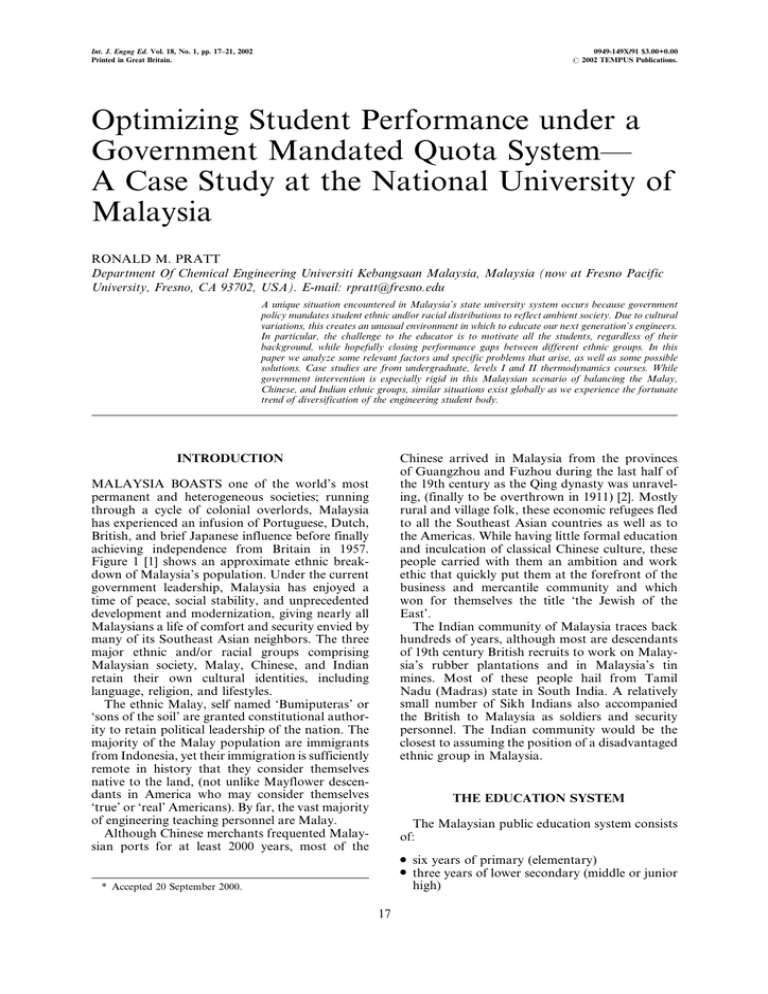Int. J. Engng Ed. Vol. 18, No. 1, pp. 17±21,... 0949-149X/91 $3.00+0.00 Printed in Great Britain. # 2002 TEMPUS Publications.
advertisement

Int. J. Engng Ed. Vol. 18, No. 1, pp. 17±21, 2002 Printed in Great Britain. 0949-149X/91 $3.00+0.00 # 2002 TEMPUS Publications. Optimizing Student Performance under a Government Mandated Quota SystemÐ A Case Study at the National University of Malaysia RONALD M. PRATT Department Of Chemical Engineering Universiti Kebangsaan Malaysia, Malaysia (now at Fresno Pacific University, Fresno, CA 93702, USA). E-mail: rpratt@fresno.edu A unique situation encountered in Malaysia's state university system occurs because government policy mandates student ethnic and/or racial distributions to reflect ambient society. Due to cultural variations, this creates an unusual environment in which to educate our next generation's engineers. In particular, the challenge to the educator is to motivate all the students, regardless of their background, while hopefully closing performance gaps between different ethnic groups. In this paper we analyze some relevant factors and specific problems that arise, as well as some possible solutions. Case studies are from undergraduate, levels I and II thermodynamics courses. While government intervention is especially rigid in this Malaysian scenario of balancing the Malay, Chinese, and Indian ethnic groups, similar situations exist globally as we experience the fortunate trend of diversification of the engineering student body. Chinese arrived in Malaysia from the provinces of Guangzhou and Fuzhou during the last half of the 19th century as the Qing dynasty was unraveling, (finally to be overthrown in 1911) [2]. Mostly rural and village folk, these economic refugees fled to all the Southeast Asian countries as well as to the Americas. While having little formal education and inculcation of classical Chinese culture, these people carried with them an ambition and work ethic that quickly put them at the forefront of the business and mercantile community and which won for themselves the title `the Jewish of the East'. The Indian community of Malaysia traces back hundreds of years, although most are descendants of 19th century British recruits to work on Malaysia's rubber plantations and in Malaysia's tin mines. Most of these people hail from Tamil Nadu (Madras) state in South India. A relatively small number of Sikh Indians also accompanied the British to Malaysia as soldiers and security personnel. The Indian community would be the closest to assuming the position of a disadvantaged ethnic group in Malaysia. INTRODUCTION MALAYSIA BOASTS one of the world's most permanent and heterogeneous societies; running through a cycle of colonial overlords, Malaysia has experienced an infusion of Portuguese, Dutch, British, and brief Japanese influence before finally achieving independence from Britain in 1957. Figure 1 [1] shows an approximate ethnic breakdown of Malaysia's population. Under the current government leadership, Malaysia has enjoyed a time of peace, social stability, and unprecedented development and modernization, giving nearly all Malaysians a life of comfort and security envied by many of its Southeast Asian neighbors. The three major ethnic and/or racial groups comprising Malaysian society, Malay, Chinese, and Indian retain their own cultural identities, including language, religion, and lifestyles. The ethnic Malay, self named `Bumiputeras' or `sons of the soil' are granted constitutional authority to retain political leadership of the nation. The majority of the Malay population are immigrants from Indonesia, yet their immigration is sufficiently remote in history that they consider themselves native to the land, (not unlike Mayflower descendants in America who may consider themselves `true' or `real' Americans). By far, the vast majority of engineering teaching personnel are Malay. Although Chinese merchants frequented Malaysian ports for at least 2000 years, most of the THE EDUCATION SYSTEM The Malaysian public education system consists of: . six years of primary (elementary) . three years of lower secondary (middle or junior high) * Accepted 20 September 2000. 17 18 R. Pratt Fig. 1. An ethnic breakdown of the population of Malaysia. . two years of upper secondary (high school) . two years of post secondary or college (something akin to an associate degree) . three to four years of higher education leading to the bachelors degree. There is a requirement for all schools, both public and private, to teach in Malay, the national language, but many schools also emphasize Mandarin Chinese, Tamil and/or English [3]. Since the students presumably come into the engineering program with a strong background in fundamental courses, the expectation is that students complete the program in three years [4]. There is a particular perception among the Chinese community that a university education is a crucial factor that leads to prestige and prosperity and Chinese families exert considerable pressure on their children to excel in school. Consequently, they are by far the most qualified to compete for the relatively few student slots in the public funded universities. To preclude a Chinese-dominated student body at Malaysia's state run universities, the government has stipulated that the student body at the universities must reflect the ethnic breakdown of society at large. (Note that the Malaysian government is not discriminating against the Chinese population, but is simply not allowing them to assume their rightful position on a `level playing field'.) This policy, however, causes tremendous bitterness among the Malaysian Chinese, and the majority of them must pursue an overseas university education at their own expense. Due to the sensitivity of this issue, university admissions data and selection criteria have not been made public since the mid 1980s [5]. The result is that comparatively few Chinese students score sufficiently high on the entrance examinations to gain admittance to university since they are competing mainly among themselves. The fortunate few who do gain admittance are far more prepared than their non-Chinese peers. In addition, due to cultural reasons, their motivation in pursuing their studies is generally greater than their non-Chinese counterparts. In contrast, to maintain the quota of Malay students at required levels, Malay students with comparatively low scores are admitted into the university system. THE CHALLENGE TO THE EDUCATOR There are two effective subgroups in every classroom, Chinese and non Chinese. Undergraduate courses in Malaysia's state universities are traditionally large, impersonal, and lecture format. There is no attempt to meet the specific needs of these two groups of students and a `one size fits all' atmosphere prevails. A final examination, (and perhaps a mid term examination as well), forms the basis for grading. It is generally among the Chinese students where much of the resentment occurs, because they feel that instructors `dumb down' the courses to accommodate their underperforming colleagues. Since the government also set hiring practices in Malaysia to favor ethnic Malay, the Chinese feel they must be much more competitive in their post-university job search. Therefore, because their motivation is high, they are eager, if somewhat disgruntled. We first consider a Thermodynamics II course offered in the winter semester of 1998 and comprising 69 students. These students were in their second year of their three year Bachelors program. The ethnic breakdown of the class was 42 Malay, 26 Chinese, and 1 Indian. Note that Chinese comprised 38% of the class, a number still considerably above their 26% in the general population. Indian students were almost totally lacking, with just one Indian student among the 69. The course was taught using English in a typically American Optimizing Student Performance under a Government Mandated Quota System 19 Fig. 2. Grade distribution among ethnic groups for Thermodynamics II. format using the text by Smith and Van Ness [6], which has long been the department standard. A portion of the grade came from class participation and in-class group activities, a rather extensive computer project replaced the midterm examination, (with homework graded and weighted heavily), and the final examination waved for those carrying a pre-final course grade of `A'. Figure 2 shows the final course grades, compared to ethnic distribution. This is a skewed distribution due to the Chinese students (except one) who all received an `A' course grade. The deviation in this distribution was unusual compared to other courses taught by other lecturers in the chemical engineering department. The reasons for this are not clear, but two possible reasons are: 1. Thermodynamics is deductive, i.e., one starts with concepts, develops a mathematical framework, and then goes about solving specific problems. The deductive nature of the subject may render it particularly difficult for less academically inclined students. 2. The homework assignments included some extra-credit problems in order to address the Chinese students who were obviously underchallenged and under stimulated; nearly all Chinese students correctly worked the extra credit problems, the other students did not. In addition, a few Chinese students indicated that in some of their other classes they were graded more harshly than their Malay counterparts thus not allowing this dichotomy to show itself. The author did not observe any evidence of this, and feels this allegation is unwarranted. It does, however, reflect the lack of trust and smoldering discontent among the Chinese students. Optional and anonymous course evaluations filled out by 63 out of the 69 students in the class gave it an overall rating of 9.06/10.0, which was an unusually high rating, especially for thermodynamics. Obviously both Chinese and Malay ethnic groups rated the course highly. A contributing factor for the high course evaluation is probably the optional final and take-home midterm project enabling many students to complete the course with no timed, in-class examination, something rather unprecedented in the department. Secondly, we consider a Thermodynamics I course consisting of 80 students given in the summer of 1999 and offered to first year, first semester students. Ethnic allocations were 54 Malay and 26 Chinese; there were no Indian students in this class. These students were starting their three-year bachelors' program after two years of post secondary study. The course was quite different, being a joint effort between two instructors, the author and a young Malay lecturer. Portions of the class were bilingual, i.e., English and Malay. Students completed the required examinations, both midterm and final; however, more than half the final grade came from class participation and homework. In addition, both instructors provided opportunities for extra credit. Figure 3 shows the course grade distribution. It is evident that even more skewing occurred in this grade and/or ethnic distribution, with all `A' course grades being received by Chinese, and all Chinese students except one receiving an `A'. Obviously the instructors have unwittingly found the secret of bifurcating the class into two performance levels strictly along ethnic lines. The course evaluations by the students (72 responses) were very positive, however roughly one third indicated difficulty with the text and lectures being in English. Unfortunately the evaluation format had changed so direct numerical comparison with the course discussed earlier is not possible. In both courses, graded, in-class (mostly group) activities accompanied nearly every lecture period. The students were encouraged to work together and were allowed to choose their own partners. The students who completed the activity early were encouraged and sometimes requested to help others who were struggling, including getting out 20 R. Pratt Fig. 3. Grade distribution among ethnic groups for Thermodynamics I. of their seats and walking around the room. For the most part (there were a few exceptions) class cooperation naturally divided strongly along ethnic lines, and students spoke their own native languages as they discussed problem solutions. Sometimes the students who finished early simply stared into space or begin talking among themselves and required instructor intervention to get them to go over and help someone. Thus far, the course instructors have refrained from assigning students to permanent, ethnically mixed workgroups. How can this performance discrepancy between Chinese and non-Chinese be closed without discouraging or imposing a `glass ceiling' on the performance of the Chinese students? It appears that more than a superficial change of teaching and grading methods is necessary. There is not a short-term remedy for this situation; the factors contributing to this difference in academic levels go back hundreds if not thousands of years, so there is a need for patience and tolerance from everyone involved. However, some measures to be taken include: 1. Limit class size so there can be more personal interaction between the students and lecturer. 2. Provide bilingual instruction, or offer multiple sections of the class in each (Malay and English) language. 3. Provide mandatory tutoring sessions for low performance students. 4. Establish an honors program or `accelerated' classes or place slower students in a four-year program. 5. Set up a contract system where students work through a certain number of modules for a certain grade. 6. Reformulate the course material to be more amenable to inductive learning. Unfortunately, Options 1 and 2 require personnel and logistical resources that are often not available. Option 3 works well to a point, beyond which cultural attitudes and `saving face' begin to come into play. (Optional help sessions consist largely of students who least need to be there.) The fourth option would be offensive to some since this would essentially make the ethnic performance bifurcation official and permanent, (as `accelerated' classes have done in American high schools). Option 5 has not been tried in this situation but appears to hold promise. Option 6 has been the most successful to date and should be fully implemented to reform the way we present the material. In most universities there is normally a large proportion of inductive or sensing [7, 8] students compared to a large proportion of deductive or intuiting instructors, although this situation could be exacerbated among Asians [9]. Students have warmly welcomed efforts to begin with specific, real life examples, followed by development of the necessary tools for dealing with these situations. Another resource involves use of the world-wideweb as a source for posting animations, videos, interactive tutorials, and `cool links'. CONCLUSIONS This problem, while described in a Malaysian context, permeates classrooms across the globe whenever we bring together students of diverse cultural backgrounds. It is most welcome to see increasing diversification of engineering student pools across the world, and our pedagogy must bend to accommodate this trend. It is essential that the abilities and initiative of the more motivated and capable students not be discouraged or compromised. However, it is equally imperative that underperforming groups of students be brought to par. This is not possible in one class, and not even in one or two generations, but some concrete steps should occur. Working within the typical logistical, human, and administrative constraints, there are things we can do: Optimizing Student Performance under a Government Mandated Quota System 1. Provide more inductive learning opportunities for sensing students. 2. Replace some lecture with mentoring; accompanied by web-based learning. 21 3. Facilitate more active student participation in the grading process. 4. Endeavor to reduce class size. REFERENCES 1. Malaysia Demographics The Commonwealth on Line http://www.tcol.co.uk/malaysia/malay2.htm 2. D. Hoobler, and T. Hoobler, The Chinese American Family Album, Oxford University Press, (1994). 3. T. K. Soon, Chemical Education and Chemistry as a Profession in Malaysia, Seminar on Education and Practice of Chemistry V (EDUPRAC V) University of Malaya, Kuala Lumpur, (3rd August 1991). 4. Panduan PrasiswazahÐKejuruteraan Kimia & Proses (Chemical Engineering Course Bulletin) Fakulti Kejuruteraan Universiti Kebangsaan Malaysia, (1999). 5. C. H. Boo, Quotas versus Affirmative ActionÐA Malaysian Perspective, Palmdale, CA: Valentine Publishers, Ch. 3 (1993). 6. J. M. Smith, H. C. Van Ness, and M. M. Abbott, Introduction to Chemical Engineering Thermodynamics, 5th Edition. New York: McGraw-Hill (1996). 7. D. Keirsey and M. Bates, Please Understand MeÐCharacter and Temperament Types, Del Mar, CA: Prometheus-Nemesis Publishers, (1984). 8. G. Lawrence, People Types and Tiger Stripes, Gainesville, FL: Center for Applications of Psychological Type Press, (1995). 9. M. H. McCaulley, E. S. Godleski, C. F. Yokomoto, L. Harrisberger, and E. D. Sloan, Applications of psychological type in engineering education, Engineering Education, pp. 394±400, (February, 1983). Ronald M. Pratt is a visiting lecturer in the engineering department at the National University of Malaysia. He obtained his BS in mathematics and in chemical engineering at the Colorado School of Mines (USA), his MS in mathematics at the Fuxin Mining Institute (China) and his Ph.D. in chemical engineering at the Colorado School of Mines. Research interests involve molecular dynamics, fractal modeling and education psychology. His teaching responsibilities have included thermodynamics and statistical thermodynamics courses, as well as courses in human resource management and organizational behavior.







